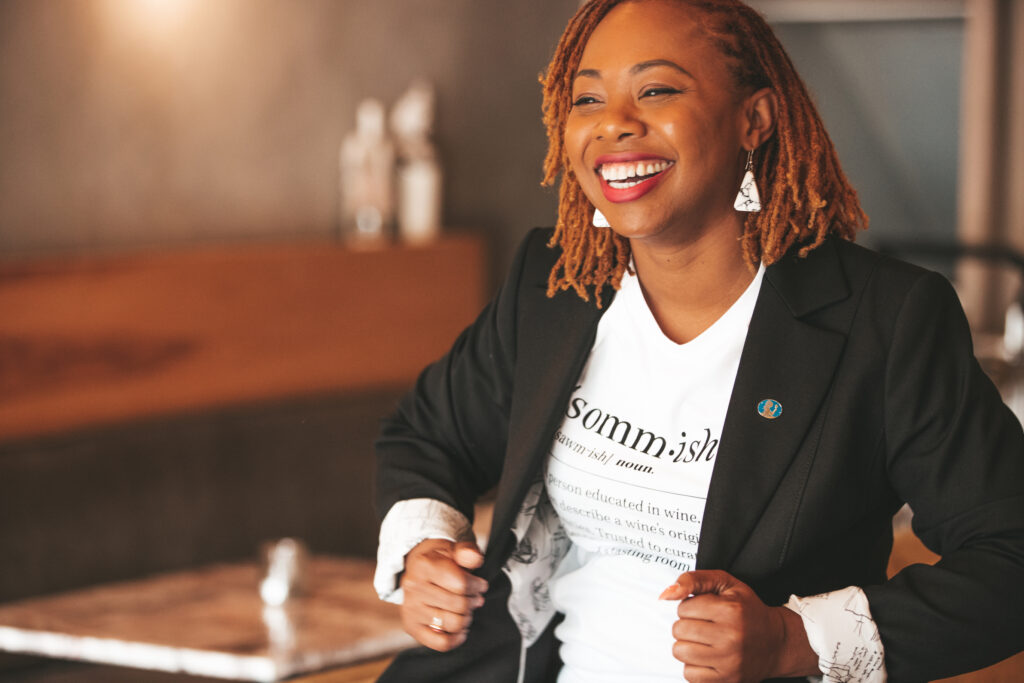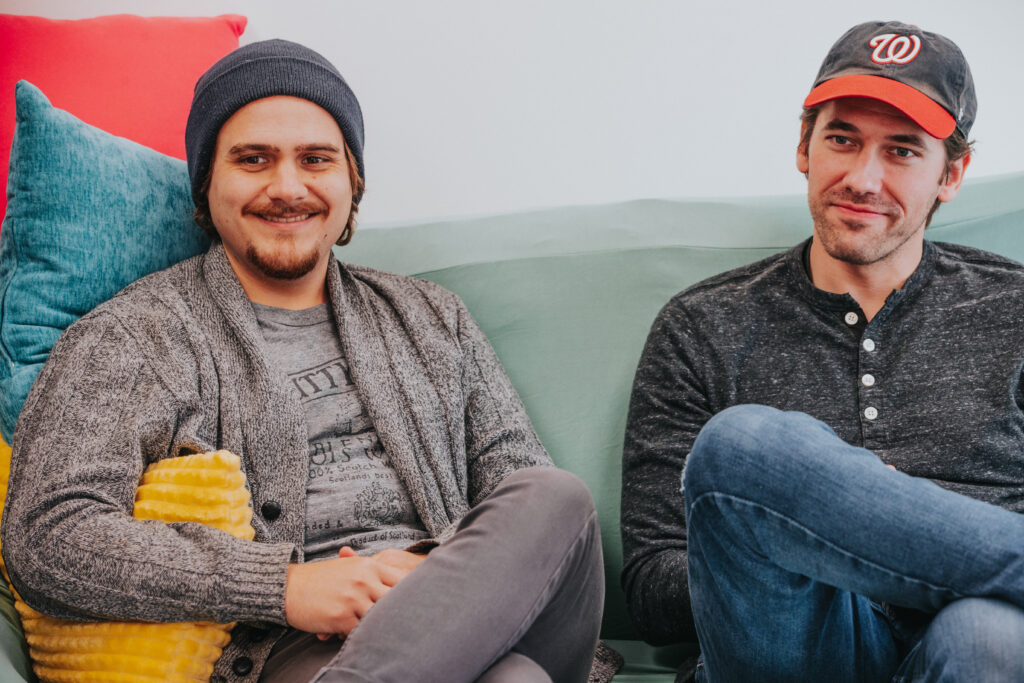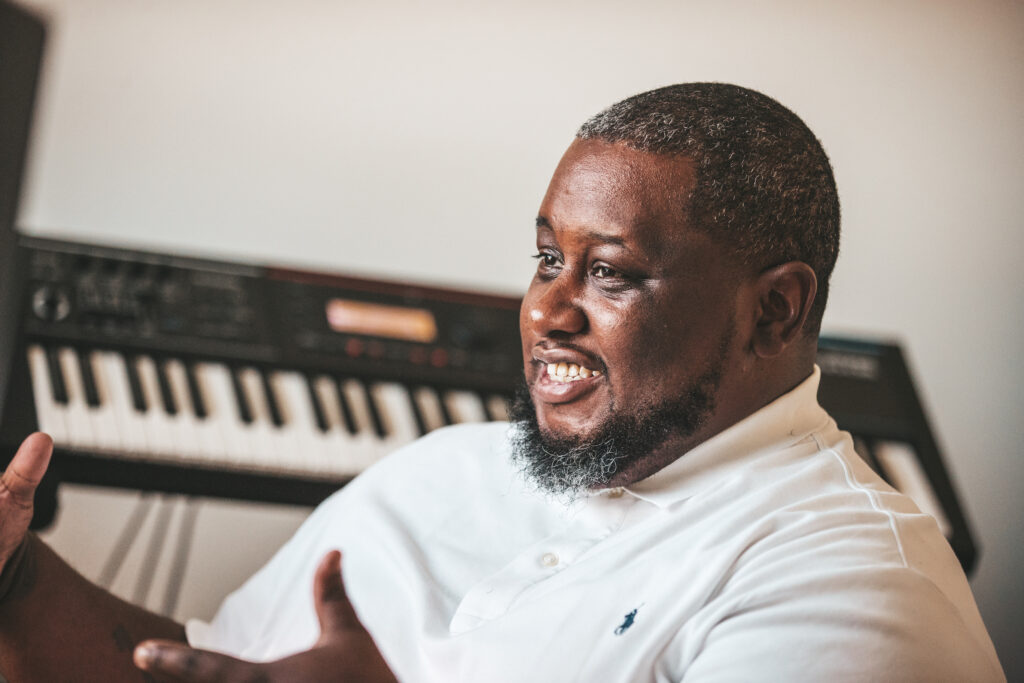“We’re here and successful because of people supporting creative ideas in Birmingham. We’ve had a lot of help along the way and try to help others as much as we can.”
Name: Brett Forsyth & Brandon Watkins
Occupation: Owners of Yellowhammer Creative
Creative Industry: Design
1. What does Creative Birmingham mean to you?
Brett: For me it means everything. We’re here and successful because of people supporting creative ideas in Birmingham. We’ve had a lot of help along the way and try to help others as much as we can.
Brandon: To me, Creative Birmingham means a community of people coming together to solve Birmingham’s problems in a creative way. Looking at things from a fresh perspective and shining light on old problems with new thinking.
2. What would you like to see happen in Birmingham in the next 5 years?
Brett: It would be really great to continue the path Birmingham is on at the moment. Folks seem to finally have a positive attitude and are chasing dreams that are fueling our city’s rebirth. I hope we can stay focused as a whole and not get blindsided by all the money flowing into the city. The rebirth of Birmingham has been a true grass roots campaign led by creative new ideas from a new generation ready to move forward from failures of the past we honestly don’t even remember because we weren’t there. I think our generation has rejected the “can’t” that always ran rampant in Birmingham and have decided to just “do.” With our fresh eyes and thoughts of preservation I’m hopeful we can keep growing into a thriving city without limits. The heart and soul of a city, as well as its success hangs so closely to the creative community. It’s very important that the creative community be active and visible. I’m afraid there’s a touch of what’s happening in Nashville now and been happening in Atlanta for years, not too mention what ruined New York long before my time. I really don’t want the city to become a homogenized metropolitan community. It’s great to see new growth and new construction as long as we don’t lose sight of why Birmingham is so great.
Brandon: I’d like to see Birmingham find its identity and not be so influenced by outsiders. I’d like for us to quit looking at what Atlanta or Nashville or any other big city is doing and try and mimic them and do things that are right for us, at this time. We need to grow Birmingham for Birmingham’s sake, this is a cool, weird place and it’s ours and I’ll fight anyone for it.
3. How did Yellowhammer Creative get started?
Brett & Brandon: Yellowhammer got started toward the end of 2008. Brandon and I shared mutual friends and got together and realized we both liked similar things. We were the only graphic designers our friends knew so obviously it was a perfect match to them. But the odd thing is it actually was the perfect match. In a lot of ways we’re like the odd couple. Brandon’s more relaxed and easy going and I’m the high-strung one who is obsessed with all the details. But at the end of the day we started YHC because we both love and are inspired by the same music, art and design. We also weren’t finding many opportunities for young designers looking for their first “real jobs” after the financial crash of 2008.
We connected originally because we both loved show posters and wanted to learn how to screen print so we could print our own show posters. It’s been great because even though we have different traits we still seem to always have the same direction for everything we do with YHC and are rarely on different pages. I think normally it’s very hard to have two people in charge, or running a company, but for us it tends to work out really well. So we got started printing posters and then that grew organically into printing shirts that we could sell to help raise capital for YHC.
Brandon had the idea to reintroduce the slogan “It’s nice to have you in Birmingham.” His initial plan was to paint a mural with the slogan somewhere in town. He pursued the idea heavily but was met with negativity and a few folks that liked the idea but wanted to bring in artists from outside Birmingham to do it. Discouraged we decided we could bring the slogan back through a grassroots campaign so we started printing the slogan on t-shirts and posters along with a few other designs that paid homage to our lovely city and state, and thus the retail arm of YHC was born.
After we gained some traction and started selling more and more shirts, and almost 5 years after originally trying to get the “It’s nice” mural painted the tide had turned and suddenly more people were willing to listen. The first mural went up in Woodlawn and was finished right before our second retail pop shop which catapulted us to quitting our full time jobs shortly after and taking YHC full time.
The slogan now has new life and has become the battle cry for the rebirth of the city. It’s been a fun ride, from working full time jobs and printing on nights and weekends in my basement to finding a place of our own and hiring employees. Luckily for us we came along and built a design and print shop at just the right time, and we did it at a nice steady pace. We were aware that we had to almost expose Birmingham to what it is we wanted to do. What it was we wanted to create. We wanted to build a design and print studio, a boutique company.
Just a few years ago our business model would have been hard to sell here in Birmingham. There was a learning curve for people to understand what made us different from other creative companies, or printers. We are to our core a flexible group of folks who love challenges and understand that with our line of work we have to not only provide support, but advice and be educators and ambassadors of the creative community. Maybe its because we’re young and naive, or just haven’t made all the mistakes yet, but we honestly try to solve every problem, or complete every project someone brings to us. If we can’t do the work ourselves we love connecting clients with other local companies and resources that may be able to help. We’re all about doing it in Birmingham. There’s no reason why it can’t all be done here.
4. What inspired you to create show posters?
Brett & Brandon: I’ve been into music for a very long time and during high school and college, and with the help of the internet I was exposed to more music than I knew was out there. Indie music and the DIY mentality came to the forefront of my life. If what I wanted wasn’t out there, then I would just roll up my sleeves and make it. I found tons of people like me and my friends – making music on their own because they loved it and wanted to chase a dream. I think we at YHC draw heavily from that mentality. There’s no reason why you can’t push yourself to be successful on your own, no matter what success means to other people. Its not always about getting that “Harry Potter Money” as we often joked in the early days of YHC. We were looking for a way to survive doing something we loved and wanted to do.
Like musicians I think most creative designers share that same urge. Most designers end up working for advertising agencies and design firms where creativity can be stifled by the process of a corporate position. Corporate America can be cushy and nice with a larger salary, but what’s that matter if you’re not totally happy and in control. We wanted YHC to be different. We were the indie artist, not the big label artist. That’s not to say we don’t have the drive to get big time clients, we just approach how we do what we do a different way, with a different mindset. We love thinking outside the box and we love the fact that everyday is a new challenge. Not being particularly musically gifted, but loving music so much, we saw our outlet for creativity and design as being the guys that could make the posters, t shirts, and album art for our friends and the musicians we loved.
The biggest outlet for us early on was the emergence of Bottletree as a creative force for Birmingham. The sheer fact that Bottletree made it off the ground where it did is mind blowing. It was a new undiscovered area for those my age. Bottletree of course prospered and single handedly brought Avondale back on the radar as a viable district for growth. Not only were they bringing in the best shows in town by far, they were so supportive of other people with dreams. From the beginning they leaned heavily on posters to promote the shows. The posters were all designed by anyone who just wanted to be a part of what was going on. The styles ranged from one end of the spectrum to the other. No one got paid for their designs but you gained free admittance to the show for you and a friend. What more could a 20 something need for their free time. It was at Bottletree that we were able to find a footing and an audience for our craft. Without the community that was built around Bottletree there’s no doubt in my mind YHC would not be the same, if here at all.
The venue gave all of us young creatives a place to go. It was our place. Our home base for what was happening in the creative community for Birmingham. A place without judgment and negativity. It was our heartbeat for 8 years. No we’ve been very lucky to make posters for all kinds of acts large and small. For some of our favorites and heroes all across the country. Just recently we were asked to design a poster for a concert at the Mother Church, the Ryman Auditorium. Jobs like that give you that warm feeling like you’re still winning the race, but none of them compare to the years where we found ourselves selling posters at Bottletree for emerging artists and dear friends.
5. Are there any Birmingham artists that have influenced your work?
Brett: Birmingham and Alabama artists have been extremely influential in my life. My knowledge of the arts was limited until I attended UAB for a graphic design degree. I was very lucky to have had great teachers who helped shape my views on art. Teachers’ like Doug Baulos who really opened my eyes to not only new mediums and processes but to ways of survival as an artist in today’s world. My wife and I also lead each other into falling in love with folk/outsider art. Alabama and the surrounding south is a hot bed for the stuff, and as far as I’m concerned it’s some of the best ever made. Artists like Thornton Dial, Jimmie Lee Sudduth, Howard Finster, John Henry Toney, the quilters of Gee’s Bend, R.A. Miller and so many others. These are people who didn’t make art because they wanted to sell expensive, “deep” art in New York. They weren’t just looking for a job that might be lucrative if it caught traction. They made it because they had no other choice. It just spewed from them. Its real, its honest. As a designer and a visual person I have unknowingly been absorbing my surroundings my whole life. I feel like Brandon and I are similar in that way.
We get asked a lot what are major influences are and while I can point to some big ones that make sense and can be linked on the surface, it really comes down to the fact that everything influences us. The bad stuff influences us just as much as the old ad cut we might find in a magazine from the 50’s that makes our heart skip a beat. In the end the good stuff gets a rise out of the viewer, it hits that chord that makes them stop and take notice. Art should not be purely decorative.
Brandon: Yes. There are so many talented people in this city it’s crazy. There are too many artists and bands and friends and organizations to mention that have contributed to us as a company and as people. Birmingham as a whole has been very influential on what we do, all of these awesome beautiful people here continue to raise the bar and we enjoy trying to keep up with it. This place is juggernaut that no one knows about yet.
6. You guys collaborate with MAKEbhm to teach a screen-printing class; why do you think it’s important to teach people the art of screen-printing?
Brett: We met Bruce Lanier of MAKEbhm when he was getting the thing off the ground. We caught wind of a maker space and thought it sounded like a cool idea. We sat down with Bruce one night in my basement and drank a few beers and talked about what drove us. We realized we matched up very well with Bruce and had the same drive for our respective efforts. He was looking to do a “dry run” for MAKEbhm in an old steam plant at the Continental Gin building in Avondale. He had a bunch of wood working equipment that he was going to use to build out a wood shop and had acquired some screen-printing equipment from a defunct school program. Bruce offered to let us use the printing equipment while it was in “storage.” We saw it as a chance to up our retail output and start offering larger volume printing services. We ended up taking over half of the building with our shirt printing, poster/flatstock room, dark room, design offices and retail space. Bruce allowed us to be able to test the waters of YHC full time without having to sign a lease or pay a lot of money for rent. With the help we received from MAKEbhm we were able to expand and grow YHC enough to realize we needed to find our own space to call our own.
While at MAKEbhm it was part of our agreement to hold classes. We were very supportive of the idea because we are completely self-taught when it comes to screen-printing. We learned trial and error through years of season changes that flipped our whole system upside down. MAKEbhm gave us a constant that we couldn’t achieve with the studio in my basement. It was our chance to share what we had learned with others who share our passion for design and screen-printing. It’s a simple enough process, but we’re still learning new things every day. It’s our way to help others explore their creativity in a more controlled environment saving them time and frustration. It’s a small contribution we can give back to the creative community of Birmingham.
Brandon: I think it’s important for people to get in there and get some hands on experience. So many shops screen print with automated machines these days and the real quality hand printed stuff is getting harder and harder to come across, so I think it’s important to try and help keep that craft alive. And once people get in there and get their hands dirty they really love it.
Photo by Daniel Drinkard.



















